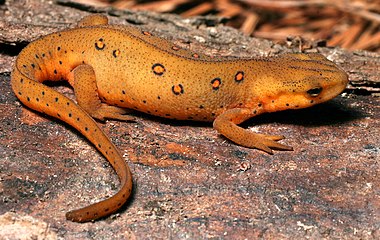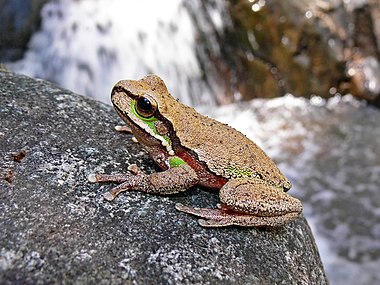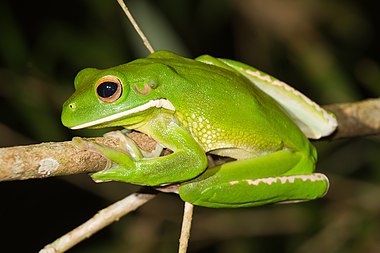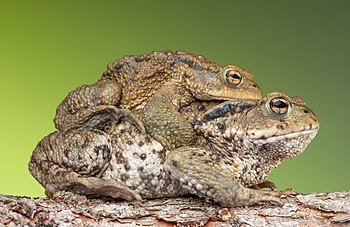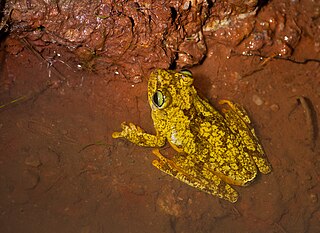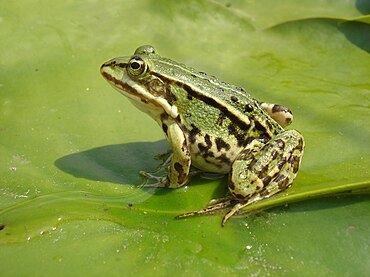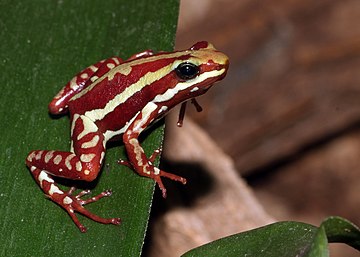Portal:Amphibians/Selected picture
The Selected picture box on the portal chooses one of the following at random when displaying the page. Follow the instructions below for adding or nominating a new picture to the list.
Picture candidates[edit]
Feel free to add related featured pictures to the list. Nominate other pictures on the portal talk page.
- Pictures must be
- Free to use and hosted on Commons
- Of good quality (not blurred, grainy or discoloured)
- Interesting
- Relevant to an article or topic
To find appropriate pictures, use search box below:
Instructions[edit]
- For pictures, which appeared as picture of the day on the Main Page, just add the date in
YYYY-MM-DDformat to the list (please keep the list sorted). - For other pictures, use following parameters:
|iN= |titleN= |creditN= |captionN=
where N is the next unused number.
Selected pictures list[edit]
In the life cycle of a frog, a female lays her eggs in a shallow pond or creek, where they will be sheltered from the current and from predators. The eggs, known as frogspawn hatch into tadpoles. The tadpoles develop gradually into adolescent froglets and finally the froglet develops into an adult frog.
Photo credit: liquidGhoul
Native to Australia, White's Tree Frog grows up to 10 centimetres in length and is a popular household pet. In captivity, they have an average lifespan of 16 years. Its skin secretions contain caerins, a group of peptides with antibacterial and antiviral properties. Other peptides have been found to destroy HIV without harming healthy T-cells.
Illustration credit: Ernst Haeckel
A frog is an amphibian characterized by long hind legs, a short body, webbed digits, protruding eyes and the absence of a tail. Frogs are most noticeable through their call, which can be widely heard during the mating season. It is estimated that up to 20% of amphibian species may care for their young in one way or another, and there is a great diversity of parental behaviours. For example, frogs in the Gastrotheca genus (upper left) carry their eggs in a pouch, and females of the Eleutherodactylus lineatus species (center left) carry their young on their back.
Photo credit: Froggydarb
A specimen from the "hybrid zone" of the Leaf Green Tree Frog (Litoria phyllochroa) and the Southern Leaf Green Tree Frog (L. nudidigitus), showing physical characteristics of both species. These small stream-dwelling frogs (averaging only 40mm in length), are native to eastern Australia and occur together south of Sydney. The two species are differentiated only by distribution, call and slight differences in flank markings.
Photo credit: Fir0002
The Eastern Banjo Frog (Limnodynastes dumerilli) is native to eastern Australia and has been introduced to New Zealand. The frog is also commonly called the pobblebonk after its distinctive "bonk" call, which is likened to a banjo string being plucked. Adults are roughly seven to eight cm long.
Photo credit: Patrick Coin
A terrestrial subadult Eastern newt or red eft (Notophthalmus viridescens). Salamanders of the family Salamandridae with aquatic adult stages are called newts. Some newts, including the Eastern newt, have a juvenile terrestrial stage called the eft. The red eft has bright aposematic coloration to warn predators of its highly toxic skin.
Photo credit: LiquidGhoul
The Red-eyed Tree Frog (Litoria chloris) is a species of tree frog native to eastern Australia; ranging from north of Sydney to Proserpine in mid-northern Queensland. These frogs typically reach a size of 65 millimetres (2.6 in). Its skin secretions have been found to destroy HIV, without harming healthy T cells.
Photo credit: LiquidGhoul
The New England Tree Frog (Litoria subglandulosa) is a species of frog native to the streams of the New England Tablelands, New South Wales, Australia.
Photo credit: Carey James Balboa
The Red-eyed Tree Frog (Agalychnis callidryas) is a small-sized tree frog, reaching lengths of about 5 to 7 centimeters (3 inches), native to Neotropical rainforests in Central America. They are not poisonous and rely on camouflage to protect them. During the day, they remain motionless with their colorful parts hidden. Thus, they appear almost completely green, and well hidden among the foliage.
Photo credit: Derek Ramsey
The American Green Frog (Rana clamitans) is native to the eastern half of the United States and Canada. Green frogs live wherever there is shallow freshwater: ponds, road-side ditches, lakes, swamps, streams and brooks. The green frog is abundant wherever it occurs.
The Blue Mountains Tree Frog (Litoria citropa) is a moderate-sized species of tree frog, up to about 60 mm (2.4 in) in length. It is native to coastal and highland areas of eastern Australia, especially in the Blue Mountains, hence its name.
The Eastern American Toad (Bufo americanus americanus) is a common subspecies of toad found throughout the eastern United States and Canada. It typically grows to 5–9 cm (2.0–3.5 in), with varying skin color and pattern depending on its environment. Its skin secretes bufotoxin, which is mildly poisonous to humans.
Photo: Lokionly
The Common Indian Toad (Duttaphrynus melanostictus) is native to South Asia. It grows to about 20 cm (8 in) long and breeds during monsoon season. These toads are often seen at night under street lamps especially during times when winged termites swarm. They have been noted to feed on a wide range of invertebrates, including scorpions.
A male Dendropsophus microcephalus frog, displaying its vocal sac—membranes of skin under the throat or on the corner of the mouth that distend to amplify its call. The species lives in moist areas in most of Central America and northern South America.
Atelopus certus is a species of toad endemic to the Darién Province of eastern Panama. Much of its range falls within the Darién National Park, a protected area and World Heritage Site. It is classified as endangered, primarily due to the advancing wave of chytridiomycosis moving through Central America.
Photo: Richard Bartz
The common frog (Rana temporaria) is found throughout much of Europe. Adults have a body length of 6 to 9 cm (2.4 to 3.5 in) and vary in colour, with the ability to lighten and darken their skin to match their surroundings. They will feed on any invertebrate of a suitable size and, apart from the breeding season, live solitary lives.
Photo: Charles H. Smith, USFWS
The golden toad (Bufo periglenes) is an extinct species of true toad that was once abundant in a small region of high-altitude cloud-covered tropical forests, about 30 km2 (12 sq mi) in area, above the city of Monteverde, Costa Rica. The last reported sighting of a golden toad was on 15 May 1989. Its sudden extinction may have been caused by chytrid fungus and extensive habitat loss.
The white-lipped tree frog (Litoria infrafrenata) is the world's largest tree frog. This species is native to the rainforests of Northern Queensland, New Guinea, the Bismarck Islands and the Admiralty Islands. It can reach a length of over 13 cm (5 in), with females growing larger than males. The lower lip has a distinctive white stripe, giving this species its common name.
Common toads in amplexus
Photo: Bernie KohlTwo common toads (Bufo bufo) in amplexus, a form of pseudocopulation found in amphibians and limulids. A male common toad grasps a female with his front legs as part of the mating process. Common toads stay in amplexus for several days. As the female lays a long, double string of small black eggs, the male fertilises them with his sperm; the gelatinous egg strings, which may contain 3000 to 6000 eggs and be 3 to 4.5 metres (10 to 15 ft) in length, are later tangled in plant stalks.
The fire salamander (Salamandra salamandra) is a European salamander species with a long lifespan. These nocturnal animals generally eat various insects, spiders, earthworms and slugs, but they also occasionally eat newts and young frogs.
The emerald-eyed tree frog (Rana platanera) is a species of frog in the family Hylidae found in South America.
Photograph: Brian Gratwicke
Rabbs' fringe-limbed treefrog (Ecnomiohyla rabborum) is a large species of frog originally found in the forest canopies of central Panama. Only discovered in 2005, the species is thought to be extinct in the wild; only one specimen, a male at the Atlanta Botanical Garden, survives.
Photo: Benny Trapp
An Italian tree frog (Hyla intermedia) with an inflated vocal sac. Vocal sacs, flexible membranes of skin possessed by most male frogs, are generally used to amplify mating or advertisement calls. However, some species in the family Rhinodermatidae may also use the sac to store or transport their tadpoles.
Photo: Quartl
Dendrobates azureus, commonly known as the blue poison dart frog or okopipi, is a poison dart frog found in the forests surrounded by the Sipaliwini Savanna in southern Suriname. Authorities have recently treated it as a variant of Dendrobates tinctorius rather than a distinct species as before.
Photo: Marie-Lan Nguyen
The marsh frog (Pelophylax ridibundus) is a species of true frog and the largest frog native to Europe; females of this sexually dimorphic species may be up to 17 centimetres (6.7 in) long. The marsh frog feeds mainly on insects, but it also eats smaller amphibians, fish, and rodents.
Photograph: Brian Gratwicke
The Panamanian golden frog (Atelopus zeteki) is a rare species of toad endemic to Panama. First described by Emmett Reid Dunn in 1933, this species was found close to mountain streams on the eastern side of the Tabasará mountain range in Coclé and Panamá Provinces, but is now critically endangered and possibly extinct in the wild.
Photograph: JJ Harrison
The southern brown tree frog (Litoria ewingii) is a species of tree frog native to Australia found in a wide range of habitats. Reaching 45 millimetres (1.8 in), this species is generally brown, but green and green-striped morphs are also recorded.
The edible frog (Pelophylax kl. esculentus) is a fertile hybrid of the pool and marsh frogs which is commonly found in Europe. The species is commonly used in food, including the French delicacy frog legs.
Photograph: H. Krisp
The phantasmal poison frog (Epipedobates tricolor) is a species of poison dart frog endemic to Ecuador. First described by George Albert Boulenger in 1899, this endangered species is found only in rainforests on the slopes of the Andes.
Photograph: Benny Trapp
The Albanian water frog (Pelophylax shqipericus) is a species of true frog in the family Ranidae. It is native to Albania and Montenegro, where it lives in aquatic environments. The frogs are medium-sized. Males sometimes bear a distinctive bright green stripe down the length of the backbone, but otherwise are green to light brown in overall colouring with large black or dark brown spots. Females are olive green or light brown in colour and also bear brown or black large spots. The species is endangered and known populations are currently in decline.
Photograph: Benny Trapp
The Spanish painted frog (Discoglossus jeanneae) is a species of frog in the family Alytidae. Endemic to Spain, it mostly lives in open areas, pine groves and shrublands. It feeds mostly on insects and worms.
Photograph: Benny Trapp
The Iberian midwife toad (Alytes cisternasii) is a species of frog in the family Alytidae found in Portugal and western Spain. Its natural habitats are temperate forests and shrubland, Mediterranean-type shrubby vegetation, intermittent rivers and freshwater marshes, pastureland, and aquaculture ponds. The species is affected by habitat loss, and the IUCN lists it as being "Near Threatened".
Photograph: Richard Bartz
Photograph: Benny Trapp
The Epirus water frog (Pelophylax epeiroticus) is a species of frog in the family Ranidae. It is found in western Greece, including Corfu, and the southern areas of Albania. The species is collected from the wild for human consumption.
Photograph: Brian Gratwicke
A female limosa harlequin frog (Atelopus limosus) in Panama. This endangered species of toad in the family Bufonidae inhabits stream banks in tropical moist lowland forests and rivers of the Chagres watershed. It is found in two colour forms, one in lowlands and one in uplands.
Photograph credit: Rushenb
Raorchestes parvulus is a small bush frog native to tropical southeastern Asia. Although the reproductive strategy of this species has not been studied, members of the family typically make a foam nest while mating in vegetation overhanging a stream. They create the foam by beating their legs, and the eggs are deposited into the nest and covered with seminal fluid before the foam hardens into a protective casing. When the eggs hatch, the young push their way out of the nest and fall into the water below.
This picture shows a male R. parvulus frog, photographed in Phu Kradueng National Park, Thailand, calling by inflating its vocal sac.
Photograph credit: Charles J. Sharp
Mantella baroni, commonly known as Baron's mantella, variegated golden frog or Madagascar poison frog, is a species of frog in the family Mantellidae. It is native to Madagascar and is seen here in Ranomafana National Park in the southeastern part of the country. The species was described in 1888 by George Albert Boulenger, who named it after its collector, Richard Baron. It has been classified as a least-concern species by the International Union for Conservation of Nature due to its relatively wide distribution, but is threatened by habitat loss. The frog's diet includes mites, which cause it to accumulate a high alkaloid concentration in its skin, making it toxic. The bright colours may serve as a warning sign to potential predators of the frog's toxicity.
Photograph credit: Petar Milošević
The agile frog (Rana dalmatina) is a species of true frog in the family Ranidae. Native to central and southern Europe, its brownish dappled colouring helps to conceal it among the leaf litter on the forest floor. This frog, about 5 cm (2.0 in) long, was photographed in the Golovec Forest in Slovenia.
Photograph credit: Charles James Sharp
The marsh frog (Pelophylax ridibundus) is a species of amphibian native to Europe and parts of Asia. It is the largest type of frog in most of its range, growing to a snout-to-vent length of around 100 mm (4 in); tadpoles can reach up to 190 mm (7.5 in) in length, but this usually occurs in places with long winters where the tadpole has time to grow. Marsh frogs hibernate during the winter, either underwater or in burrows, and are able to use the Earth's magnetic field to locate breeding ponds. This marsh frog was photographed in Kampinos National Park, Poland.
Photograph credit: Rushenb
Wallace's flying frog (Rhacophorus nigropalmatus) is a moss frog found in tropical southeastern Asia. It is named after the British naturalist Alfred R. Wallace, who collected the first known specimen of the species. It lives almost exclusively in trees, and when threatened, or in search of prey, will leap from a branch and splay its four webbed feet; the membranes between its toes and the loose skin flaps on its sides catch the air as it falls, helping it to glide. This individual was photographed in Khao Sok National Park, Thailand.






